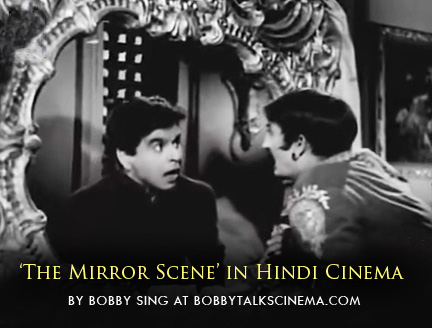
Based on an unusual theme, Manmohan Desai’s Mard (1985) was a successful film of the director, having a few notable deviations from his routine format. Apart from being a pre-independence period drama featuring Amitabh Bachchan as the solo hero, it also had music by Anu Malik making a grand entry into the camp. But most importantly, it was also the director’s first film that got criticized for its crude humour, particularly in the song “Hum to tambu mein bambu lagaye baithe”.
However, this is about a comic sequence that comes just before the song in the film and has a long history in Hindi cinema, taking its clear inspiration from the famous western classics. This funny sequence in Mard has both Amitabh and Prem Chopra facing each other with a mirror in between (that closes down suddenly) and the drunken Prem considers Amitabh as his mirror image. Prem laughs, makes faces, and even slaps himself to check if the image is real, and Amitabh keeps imitating him hilariously before hitting him hard, coming out of the mirror. As he knocks down Prem, the controversial song breaks in which surely was a strange insertion in a Manmohan Desai film, not known for such desperate attention-seeking additions.
Before Mard, the exact scene was earlier seen in Sultan Ahmed’s Pyar Ka Rishta (1973) featuring Johnny Walker and Yunus Parvez in their brass band troupe attires. As Johny is romancing with a girl in her house, the father (Yunus) comes in and Johny has no place to hide in the small room. He finally stands behind a wooden frame (that hasn’t got the mirror in it) and starts imitating Yunus. As both are wearing identical costumes, Yunus first considers him as his mirror image, but then gets suspicious and catches Johny grabbing his false beard.
Interestingly, even before Pyar Ka Rishta, the same sequence was also there in Dilip Kumar’s Kohinoor (1960-B/W), directed by S. U. Sunny. In a similar situation, here too, the moment Jeevan comes into Meena Kumari’s room in the palace (in a drunken state), he suspects someone is there and finds Dilip standing behind the mirror. As he reaches close, Dilip imitates his every act as the mirror image, creating a hilarious situation before Meena begins her dance to distract Jeevan.
In comparative terms, though the Kohinoor sequence remains the most elaborate, enjoyable, and well-enacted one, the scene in Pyar Ka Rishta is the most logical among the three, as there we have both the actors wearing exactly similar attires. This major requirement for the scene in both Kohinoor and Mard remains missing.
Possibly, there might be another similar instance exploiting the same in Hindi cinema even before Kohinoor. But that still cannot be an original, because the actual inspiration for all such similar sequences remains the Western comedy classics made in the initial decades of the twentieth century.
The most famous among them is the Marx Brothers film Duck Soup released in 1933. Widely quoted as the source of inspiration for many, it still isn’t the original, as the sequence also appeared in Max Linder’s Seven Years Bad Luck (1921), in which a servant accidentally breaks a mirror and then tries to imitate his master’s action standing behind the empty frame. Just two years before that, the same was also witnessed in Harold Lloyd’s short film, The Marathon in 1919.
Popularly quoted as ‘the mirror scene’ in books and articles, it got later adapted in a few famous English TV series too before getting featured in our Hindi films. Coming back to Manmohan Desai-Amitabh Bachchan cinema, one of the most famous sequences of their films is another ‘mirror sequence’ conceived innovatively in Amar Akbar Anthony (1977). Though it doesn’t find any mention in their interviews or detailed write-ups, probably the team had the cult western ‘mirror scene’ in mind before going for their own original Anthony version. The thought carries some weight as the renowned actor and director replicated the same in Mard after around a decade of Amar Akbar Anthony.
Concluding on a distinct note, it’s truly amazing to realize that the sequence written and performed a century back in the era of silent films, still holds enough potential to entertain the new millennium viewers.
Cheers!
Bobby Sing
bobbytalkscinema.com
NOTE : The article was first published in THE FREE PRESS JOURNAL Newspaper (Mumbai Edition) on 3rd October 2021.
Note : The write-up is a chapter shared from my upcoming book releasing soon. So any additions, rectifications suggested by friends are welcome to make it better.
----------
 For more such interesting articles on lesser known facts on Hindi Cinema, do try DID YOU KNOW
For more such interesting articles on lesser known facts on Hindi Cinema, do try DID YOU KNOW Series by
Bobby Sing available in both
Book and
E-book form
.
Also available
at Notionpress and Flipkart stores (in India)
The book is now also available in Hindi titled ITNA TO YAAD HAI MUJHE published by Prabhat Prakashan
Available at all leading portals online.


 For more such interesting articles on lesser known facts on Hindi Cinema, do try DID YOU KNOW Series by Bobby Sing available in both Book and E-book form.
For more such interesting articles on lesser known facts on Hindi Cinema, do try DID YOU KNOW Series by Bobby Sing available in both Book and E-book form.